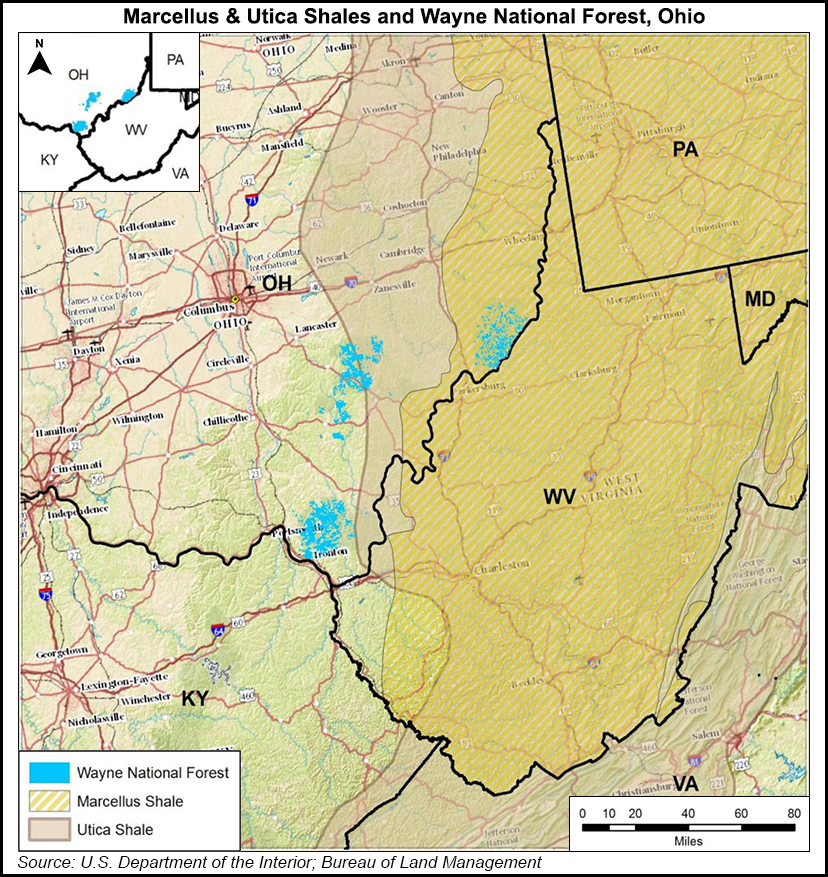Utica Shale | E&P | NGI All News Access | NGI The Weekly Gas Market Report | Regulatory
Oil, NatGas Leasing in Ohio National Forest Paused After Court Finds Regulators Ignored Drilling Impacts
Federal oil and gas leasing in Ohio’s only national forest has been suspended after a court agreed with environmental groups that the Bureau of Land Management (BLM) and the U.S. Forest Service (USFS) failed to adequately consider the impact of unconventional development when they opened the land for drilling.

In a 72-page ruling, the U.S. District Court for the Southern District of Ohio said the agencies “demonstrated a disregard for the different types of impacts” caused by horizontal wells completed with modern hydraulic fracturing techniques, compared to less intensive conventional drilling. Regulators, the court said, specifically failed to consider surface area disturbance, impacts on the Indiana Bat and the Little Muskingum river and on regional air quality.
The ruling is the latest in a long-running battle over whether exploration and production companies should be allowed to operate in the Wayne National Forest (WNF). The case will now proceed to determine whether earlier lease sales should be voided. The agencies might also take a closer look at their environmental review to strengthen it in the meantime, the court noted.
Citing the court’s ruling, the BLM Eastern States Office removed 13 parcels in the forest that it had planned to auction on Thursday during its regularly scheduled quarterly lease sale.
Four environmental groups, led by the Center for Biological Diversity, filed a lawsuit against BLM and USFS in 2017 to void oil and gas leases and stop unconventional development in the WNF. The American Petroleum Institute, Independent Petroleum Association of America and an affiliate of Montage Resources Corp., which holds many of the leases in the forest, have intervened in the case.
The BLM in 2015 proposed to lease parcels across 40,000 acres in the forest’s Marietta Unit in Monroe, Noble and Washington counties that were nominated by the industry for unconventional development. The Eastern States Office began auctioning parcels shortly thereafter and over 2,000 acres in the forest have since been leased for Utica Shale development, generating more than $7 million.
The decision to ultimately lease land in 2015 came three years after the agency signed a supplemental information report (SIR). The report concluded that there was no need to amend the forest’s 2006 land and resource management plan or supplement its environmental impact statement to address the impacts from unconventional drilling.
BLM released an environmental assessment (EA) in 2016 that found unconventional oil and gas development in the forest would have no effect on climate, water quality or public health. The environmental groups, however, argued that the latest environmental reviews relied on outdated information.
The court agreed, saying that both the 2012 SIR and 2016 EA both relied on the 2006 plans. U.S. District Judge Michael Watson said the agencies never “stopped to take that hard look that was required of them” when it came to reviewing the impacts of unconventional development.
© 2024 Natural Gas Intelligence. All rights reserved.
ISSN © 2577-9877 | ISSN © 1532-1266 | ISSN © 2158-8023 |
